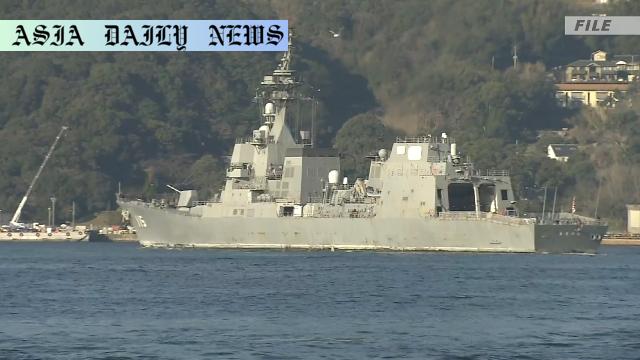Taiwan Strait: Japanese MSDF Akizuki transits in February 2023, emphasizing maritime freedom amidst China’s growing protests.
- Japanese destroyer Akizuki makes its second transit through the Taiwan Strait.
- The move underscores commitment to freedom of navigation in international waters.
- China continues its protests against foreign naval vessel operations in the region.

Japanese Destroyer Akizuki’s 2nd Taiwan Strait Passage
The Japanese Maritime Self-Defense Force (MSDF) destroyer Akizuki has navigated the Taiwan Strait for a second time, highlighting Japan’s commitment to upholding freedom of navigation in contested waters. This maneuver, carried out in early February, comes on the heels of Akizuki’s first passage in September of the previous year. The event underscores Japan’s strategic stance amidst rising tensions in the Asia-Pacific region, particularly with China growing increasingly vocal about its territorial claims in the Taiwan Strait.
The Taiwan Strait holds heightened geopolitical significance as it serves as a crucial waterway connecting East Asian economies with the broader Asia-Pacific. The United States, Japan, and their allies maintain that the strait is part of international waters and is accessible to all naval vessels. By contrast, China claims sovereignty over the strait and opposes the presence of foreign warships, including transits by U.S. naval and allied vessels. Akizuki’s second transit thus sends a message of solidarity with international allies and reinforces Japan’s own defense and maritime strategies.
China’s Response: A Pattern of Protest
China’s reaction mirrored its earlier responses to similar passages. Beijing protested strongly, labeling foreign naval activity in the Taiwan Strait as provocative and infringing on its territorial integrity. Nevertheless, Japan’s action aligns with the broader movement led by countries such as the U.S., which advocate for an open and rules-based international order. This recent development forms part of a series of freedom-of-navigation operations conducted by global powers in response to China’s territorial assertiveness, including its construction of artificial islands and military outposts in the South China Sea.
Strategic Importance of Japanese Naval Action
Japan’s actions are also significant domestically, as they mark a tangible shift in its defense policy. The MSDF’s increasing regional presence signals a resolve to play an active security role amid destabilizing unilateral actions in its vicinity. This maneuver also reflects the significance Japan places on safeguarding vital sea lanes that are essential for its economic stability. Furthermore, the Strait navigation serves as a demonstration of Japan’s advancement in coordinating maritime operations with international allies, thus bolstering cooperative security measures in the Indo-Pacific.
Freedom of Navigation: A Global Priority
Japan’s transit through the Taiwan Strait is a small yet symbolic act within a broader framework aimed at sustaining freedom and stability in maritime trade routes. This principle is critical not just for Japan but for the global trading community due to the significance of uninterrupted shipping lanes. The international alliance between nations such as the U.S., Japan, and Australia emphasizes this point. While China persistently calls for controlled access, the maneuvers by democratic powers demonstrate opposition to coercive tactics that undermine international norms and agreements.
Looking Towards the Future
As tensions intensify around the Taiwan Strait, Japan’s proactive moves such as Akizuki’s transits are likely to establish a precedent. These initiatives reflect not only Tokyo’s security concerns but also its increasing willingness to assert its position amidst regional challenges. The significance of such actions extends beyond the symbolic value, offering insight into the evolving dynamics within the Indo-Pacific and the role Japan plays in shaping a collaborative security framework for the future.



Commentary
Insight into Japan’s Assertion of Maritime Rights
Japan’s decision to send the MSDF destroyer Akizuki through the Taiwan Strait for a second time is a powerful demonstration of its support for freedom of navigation—a principle critical to maintaining order in global maritime routes. This decision is particularly significant given the mounting geopolitical tensions spurred by China’s assertive territorial claims in the region. Through this act, Japan is not merely staking a claim of maritime access but also signaling its intent to stand alongside key allies, including the United States, in preserving international order.
China’s Growing Resistance
Unsurprisingly, China’s protests following the destroyer’s passage reflect its continued stance against foreign military presence in the Taiwan Strait. What makes this situation more intricate is the Strait’s role as not just a geopolitical flashpoint but a vital economic pathway. China’s opposition poses a nuanced challenge, as diplomatic measures combined with strategic military operations will be increasingly needed to address Beijing’s escalating influence. Japan’s continued participation in such operations indicates its commitment to opposing unilateral actions that threaten global norms.
Japan’s Strategic Role in the Region
Japan’s growing involvement in the security of the Asia-Pacific is a commendable move that demonstrates an evolution in its defense policy. The Akizuki’s transit reinforces not only Japan’s maritime sovereignty but also its broader participation in global security concerns. The international community, particularly countries reliant on stable trade routes, will certainly view Japan’s maneuvers as a necessary and stabilizing force. Such actions remind the world of the importance of standing firm against efforts to monopolize shared global resources.
Conclusion
Japan’s naval operations, such as Akizuki’s transit, underscore its proactive position in safeguarding freedom of navigation. These actions do not only challenge China’s territorial assertions but also play a pivotal role in shaping the Asia-Pacific’s security architecture. As regional tensions evolve, it will be imperative for Japan to continue its balanced approach—demonstrating strength while engaging diplomatically with all stakeholders involved.